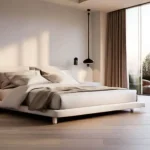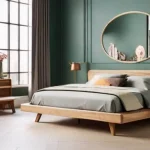Imagine walking into your bedroom and being greeted by the rich, warm feel of hardwood beneath your feet. Hardwood floors are a timeless choice that can transform the look and feel of your bedroom, offering a blend of elegance and durability that few other flooring options can match. Whether you’re remodeling your current space or building a new one, choosing to install a hardwood floor for your bedroom is a decision that can add both beauty and value to your home.
Explore everything you need to know about installing hardwood floors in your bedroom, from the benefits of choosing hardwood to the step-by-step process of installation. By the end, you’ll have all the information you need to make your bedroom the cozy, stylish retreat you’ve always wanted.
Benefits of Installing Hardwood Floors in the Bedroom
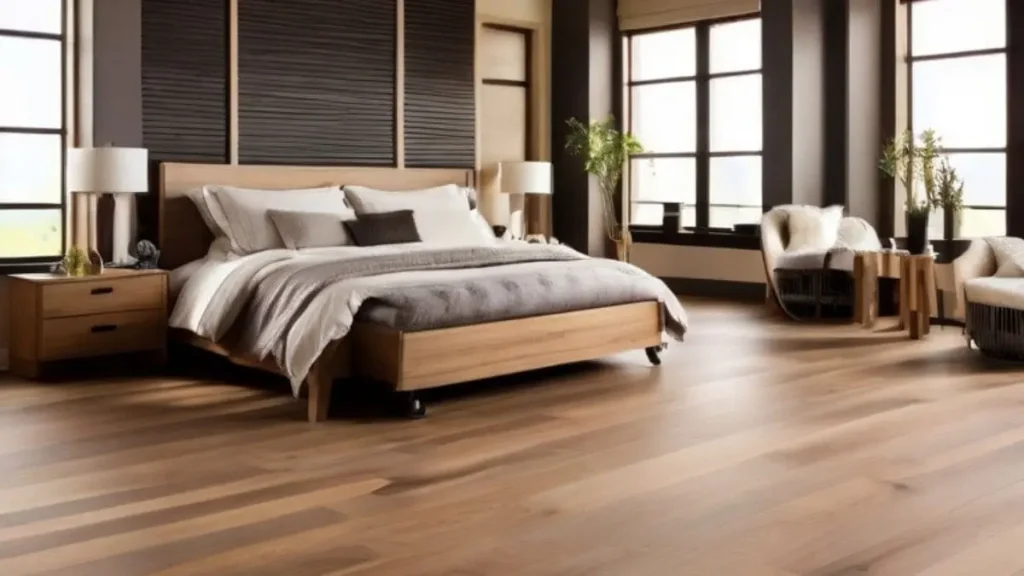
Elegance and Warmth
There’s something undeniably inviting about hardwood floors. The natural beauty of wood, with its unique grain patterns and warm tones, can make any bedroom feel more elegant and cozy. Hardwood floors work beautifully with various design styles, from modern minimalism to classic traditional, making them a versatile choice for any home.
Durability and Longevity
Hardwood floors are known for their durability. With proper care, they can last for decades, making them a wise investment for your bedroom. Unlike carpets that may need to be replaced every few years, hardwood floors can withstand daily wear and tear, ensuring that your bedroom remains beautiful for years to come.
Hypoallergenic and Easy to Clean
If you or your family members suffer from allergies, hardwood floors can be a great option. Unlike carpets, which can trap dust, pet dander, and other allergens, hardwood floors are easy to clean and don’t harbor allergens. A simple sweep or vacuum and occasional mopping are all it takes to keep them looking their best.
Resale Value
Installing hardwood floors in your bedroom is not just about immediate aesthetic appeal; it’s also a smart financial move. Homes with hardwood flooring are often more attractive to potential buyers, and many are willing to pay a premium for this feature. So, if you ever decide to sell your home, the investment you made in hardwood flooring could pay off significantly.
Types of Hardwood Floors Suitable for Bedrooms

When it comes to choosing the right hardwood floor for your bedroom, you’ll find that you have several options, each with its own set of advantages. Understanding the differences between these types can help you make an informed decision that suits your style, budget, and the specific needs of your bedroom.
Solid Hardwood
Solid hardwood flooring is made from a single piece of wood, typically about ¾ inch thick. This type of flooring is prized for its authenticity and longevity. Because it’s solid wood all the way through, it can be sanded and refinished multiple times, making it a long-lasting option.
The beauty of solid hardwood lies in its natural variation and warmth, which can add a timeless charm to your bedroom. However, it’s important to note that solid hardwood can be more susceptible to moisture and humidity changes, so it may not be ideal for every climate.
Engineered Hardwood
Engineered hardwood is a more versatile and often more affordable alternative to solid hardwood. It’s made by bonding layers of wood together, with a top layer of genuine hardwood and multiple layers of plywood or other materials underneath.
This construction makes engineered hardwood more stable and less prone to warping or expanding due to moisture, making it a great option for bedrooms in more humid climates. While it can be sanded and refinished, it’s typically only possible once or twice due to the thinner top layer.
Bamboo and Exotic Woods
If you’re looking for something a bit more unique, consider bamboo or other exotic hardwoods. Bamboo flooring, while technically a grass, is incredibly durable and eco-friendly.
It has a distinct look that can set your bedroom apart. Exotic hardwoods, such as Brazilian cherry or teak, offer rich, vibrant colors and unusual grain patterns that can add a luxurious feel to your bedroom. However, these options can be more expensive and may require more maintenance to keep them looking their best.
How to Choose the Right Hardwood for Your Bedroom
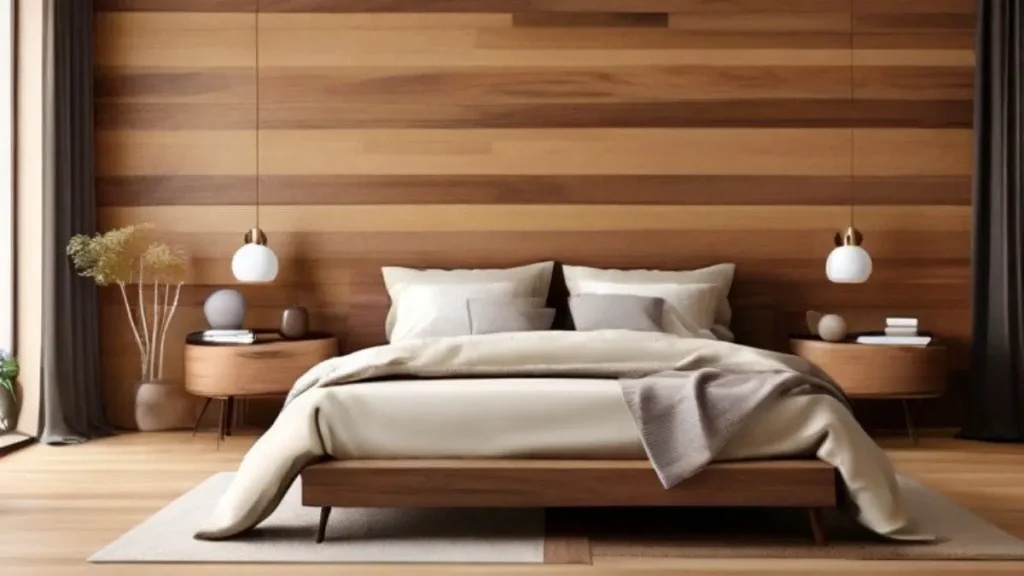
Selecting the right hardwood floor for your bedroom involves more than just picking a color you like. You’ll want to consider various factors to ensure you’re making the best choice for your space and lifestyle. Here’s what to keep in mind:
Consider Wood Species
Different wood species offer different levels of hardness, color, and grain patterns. Oak, for example, is one of the most popular choices due to its durability and classic look. Maple offers a lighter color and a more subtle grain, making it ideal for modern or minimalist bedrooms.
Cherry wood is known for its rich, deep color and smooth grain, adding a touch of luxury to any room. Consider the overall aesthetic you want to achieve and how much traffic your bedroom typically gets when choosing the species.
Grain Patterns and Color Options
The grain pattern of the wood can greatly affect the overall look of your bedroom. Some woods, like oak, have a more pronounced grain, which can add texture and visual interest.
Others, like maple, have a smoother, more uniform appearance. In terms of color, hardwood floors come in a wide range, from light, airy shades to deep, rich tones. Lighter colors can make a small bedroom feel larger, while darker tones add coziness and warmth. Choose a color and grain pattern that complements your existing furniture and decor.
Finish Types
The finish you choose will impact both the appearance and durability of your hardwood floors. Matte finishes offer a more natural, understated look and are great for hiding scratches and dust.
Satin finishes strike a balance between matte and gloss, providing a slight sheen without being too reflective. Gloss finishes are shiny and reflective, making them perfect for a more polished, luxurious bedroom.
Consider your lifestyle and how much maintenance you’re willing to do when selecting a finish.
Plank Width and Thickness
The width and thickness of the planks can change the entire feel of your bedroom. Wider planks tend to create a more modern, open look, while narrower planks offer a traditional, classic appearance.
Thicker planks provide more stability and can be refinished more times, which adds to the longevity of your floor. However, they can also be more expensive. Think about the size of your bedroom and your design preferences when choosing the plank size.
Cost Considerations
Budget is always an important factor when selecting hardwood flooring. Solid hardwood generally costs more than engineered hardwood, and exotic woods tend to be pricier than domestic species like oak or maple.
However, consider the long-term value—while some options might require a higher upfront cost, their durability and the potential increase in your home’s resale value could make them a worthwhile investment. It’s also important to factor in installation costs and any additional expenses, such as underlayment or finishing materials.
Step-by-Step Guide to Installing Hardwood Floors in the Bedroom
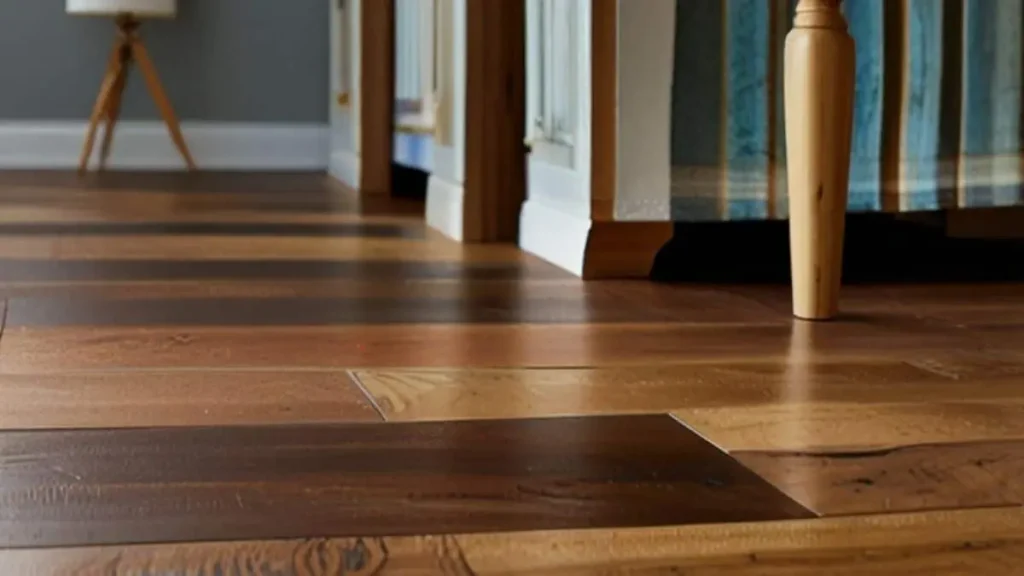
Installing a hardwood floor for your bedroom is a rewarding project that can elevate the aesthetic of your space while adding value to your home. While it may seem daunting at first, breaking down the process into manageable steps can make it much more approachable. Here’s a step-by-step guide to help you through the installation:
Step 1: Gather Your Materials and Tools
Before you begin, ensure you have all the necessary materials and tools. You’ll need hardwood flooring planks, underlayment, a moisture barrier (if needed), a tape measure, a saw, a hammer, nails or a nail gun, a flooring nailer, spacers, and a pry bar. Having everything on hand will save you time and frustration during the installation process.
Step 2: Prepare the Subfloor
Start by preparing the subfloor. Ensure it’s clean, dry, and level. If there are any uneven spots, sand them down or use a leveling compound to create a smooth surface. If your subfloor is concrete, you may need to install a moisture barrier to prevent moisture from affecting your hardwood. Proper preparation of the subfloor is crucial for a successful installation and the longevity of your hardwood floor.
Step 3: Acclimate the Hardwood Planks
Hardwood planks need to acclimate to the room’s temperature and humidity before installation. Place the planks in the bedroom where they’ll be installed and let them sit for at least 48 hours. This step helps prevent the wood from expanding or contracting after installation, which can lead to gaps or buckling.
Step 4: Install the Underlayment
Next, roll out the underlayment across the entire floor, ensuring it covers every inch of the subfloor. The underlayment provides a cushioning effect, helps reduce noise, and acts as an additional moisture barrier. Be sure to overlap the seams and tape them down securely.
Step 5: Start Laying the First Row
Begin installing the hardwood planks along the longest wall, leaving a small gap (usually about ¼ inch) between the planks and the wall to allow for expansion. Use spacers to maintain this gap as you work.
The first row is crucial, so take your time to ensure it’s perfectly straight. Secure the planks by nailing them into the subfloor along the edge where they’ll be covered by baseboards.
Step 6: Continue Laying the Planks
Once the first row is in place, continue laying the planks row by row. Stagger the seams by cutting the first plank in each new row to a different length. This not only adds visual appeal but also strengthens the floor’s structure.
Use a flooring nailer to secure the planks, being careful not to damage the wood. For the last row, you may need to cut the planks lengthwise to fit, and then use a pry bar to fit them snugly into place.
Step 7: Install the Baseboards and Finish
After all the planks are installed, remove the spacers and install the baseboards to cover the expansion gaps around the room’s perimeter. This gives the floor a clean, finished look. Finally, sweep or vacuum the floor to remove any dust or debris, and enjoy your new hardwood floor for your bedroom!
Cost Considerations for Installing Hardwood Floors in a Bedroom

The cost of installing a hardwood floor in your bedroom can vary widely depending on several factors, including the type of hardwood you choose, the size of the room, and whether you opt for professional installation or a DIY approach. Here’s a breakdown of the key cost considerations:
Cost of Materials
The cost of hardwood flooring materials is typically the most significant part of your budget. Solid hardwood generally costs between $5 and $15 per square foot, depending on the species and quality. Engineered hardwood is often slightly less expensive, ranging from $3 to $10 per square foot.
Exotic woods like Brazilian cherry or teak can be on the higher end of the price spectrum, while more common options like oak or maple are more affordable.
Labor Costs
If you hire a professional to install your hardwood floors, labor costs will be an additional expense. On average, professional installation can range from $3 to $8 per square foot. This cost includes preparing the subfloor, laying the hardwood planks, and finishing the edges.
While DIY installation can save you money on labor, it’s important to factor in the time and effort required, as well as the potential need for special tools.
Additional Materials
Beyond the hardwood planks, you’ll need to budget for underlayment, moisture barriers, nails, and baseboards. These additional materials can add anywhere from $1 to $3 per square foot to your overall cost.
Don’t forget to account for any tools you may need to purchase or rent if you’re doing the installation yourself.
Waste Factor
When calculating the amount of hardwood flooring you’ll need, it’s essential to account for waste. Most experts recommend purchasing 5% to 10% more flooring than the exact square footage of your room to account for cutting mistakes, defective planks, and future repairs. This small buffer can prevent delays and ensure a seamless installation.
Long-Term Value
While hardwood flooring may have a higher upfront cost compared to other flooring options like carpet or laminate, it’s important to consider the long-term value. Hardwood floors are durable and can last for decades with proper care.
They also tend to increase the resale value of your home, making them a wise investment in the long run.
Potential Hidden Costs
Be aware of potential hidden costs that may arise during the installation process. For instance, if your subfloor is uneven or damaged, you may need to pay for repairs or additional materials to correct the issue.
Also, if you live in an older home, you might encounter unexpected challenges, such as removing old flooring or dealing with asbestos, which can increase costs.
Common Mistakes to Avoid When Installing Hardwood Floors
Installing a hardwood floor in your bedroom is a significant investment, and ensuring that the installation process goes smoothly is crucial for achieving a beautiful, durable result. However, there are some common mistakes that can derail the project or lead to issues down the line. Here’s what to watch out for:
Skipping Subfloor Preparation
One of the most common mistakes is neglecting to properly prepare the subfloor. An uneven or dirty subfloor can cause the hardwood planks to sit unevenly, leading to gaps, squeaks, and even structural issues over time. Always take the time to thoroughly clean, level, and dry the subfloor before beginning the installation.
Not Acclimating the Hardwood
Hardwood is a natural material that expands and contracts with changes in temperature and humidity. Failing to acclimate the wood to the bedroom’s environment before installation can result in warping, gaps, or buckling after the floor is laid. Always allow the hardwood planks to sit in the room for at least 48 hours to adjust to the ambient conditions.
Improper Placement of Nails or Staples
Securing the hardwood planks with nails or staples is essential for stability, but improper placement can cause issues. Nails or staples that are too close to the edge of the plank can cause splitting, while those that are too far apart can lead to loose boards. Use a flooring nailer to ensure the fasteners are placed correctly and at regular intervals.
Ignoring the Expansion Gap
Hardwood floors need room to expand and contract with changes in humidity. Failing to leave an expansion gap around the perimeter of the room can lead to buckling or warping as the wood expands. Always use spacers to maintain a consistent gap between the floor and the walls, which can be covered by baseboards later.
Rushing the Installation Process
Installing hardwood floors is a project that requires precision and patience. Rushing through the process, especially during critical steps like laying the first row or cutting planks to size, can lead to mistakes that are difficult to correct later. Take your time, double-check your measurements, and don’t hesitate to adjust as needed to ensure a perfect fit.
Not Accounting for Waste
Another common mistake is ordering just enough hardwood to cover the exact square footage of the room. This approach doesn’t account for waste due to cutting errors, defective boards, or future repairs. Always purchase 5% to 10% more flooring than you think you’ll need to avoid running out mid-project.
Maintenance Tips for Bedroom Hardwood Floors

Once you’ve installed your beautiful new hardwood floor in your bedroom, it’s important to keep it looking its best. Proper maintenance will not only preserve the floor’s appearance but also extend its lifespan. Here are some practical tips for caring for your bedroom hardwood floors:
Regular Cleaning
Keeping your hardwood floors clean is essential for maintaining their beauty. Dust and dirt can scratch the surface, so it’s important to sweep or vacuum regularly. Use a soft-bristle broom or a vacuum with a hardwood floor attachment to avoid damaging the finish.
For a deeper clean, use a damp mop with a hardwood floor cleaner, but be sure to avoid excessive water, as it can seep into the wood and cause damage.
Protect from Scratches
Scratches are one of the most common issues with hardwood floors, but they can be minimized with a few simple precautions. Place felt pads under furniture legs to prevent scratches when moving items around.
If you have pets, keep their nails trimmed to avoid gouges in the wood. Also, consider using area rugs in high-traffic areas to protect the floor from wear and tear.
Control Humidity Levels
Humidity can have a significant impact on hardwood floors, causing the wood to expand or contract. To prevent issues like warping or gaps, try to maintain a consistent humidity level in your bedroom, ideally between 35% and 55%.
Using a humidifier in the winter and a dehumidifier in the summer can help regulate the moisture levels in the air.
Use the Right Cleaning Products
Using the wrong cleaning products can dull the finish or damage the wood. Avoid harsh chemicals, abrasive cleaners, or oil-based soaps, as these can leave a residue or strip the finish. Instead, use a cleaner specifically designed for hardwood floors, which will gently clean without harming the surface. Always follow the manufacturer’s instructions for the best results.
Avoid Excessive Sunlight
Prolonged exposure to direct sunlight can cause your hardwood floors to fade or discolor over time. To protect your floors, use curtains, blinds, or UV-blocking window films to limit the amount of sunlight that reaches the wood. Additionally, you can periodically rearrange furniture and rugs to ensure that any color changes are even across the floor.
Address Spills and Stains Promptly
While hardwood floors are more resistant to stains than carpet, it’s still important to clean up spills as soon as they occur. Use a soft, dry cloth to blot the spill, and then clean the area with a damp cloth if needed. Avoid letting water sit on the floor, as it can seep into the seams and cause damage. For tougher stains, use a wood floor cleaner or consult a professional.
Reapply Finish as Needed
Over time, the finish on your hardwood floors may start to wear down, especially in high-traffic areas. To keep your floors looking their best, you may need to reapply the finish every few years.
Depending on the type of finish, this could involve screening and recoating the floor or even sanding it down and applying a new finish. Regularly assessing the condition of your floor’s finish will help you determine when it’s time for maintenance.
Conclusion
Installing a hardwood floor in your bedroom is more than just a home improvement project—it’s an investment in the comfort, style, and value of your home. With the right preparation, material selection, and installation techniques, you can create a stunning, long-lasting floor that enhances the warmth and elegance of your bedroom.
From understanding the benefits and types of hardwood to learning how to avoid common installation mistakes, this guide has equipped you with the knowledge you need to achieve a successful project.
Remember, the key to a beautiful hardwood floor lies in careful planning, attention to detail, and regular maintenance.
Whether you’re a DIY enthusiast or working with a professional, taking the time to do it right will ensure that your bedroom hardwood floor is something you can enjoy for many years to come.
These tips and guidelines, you can transform your bedroom into a cozy, inviting space that reflects your personal style while providing the durability and timeless appeal of hardwood.
So, take that first step towards your dream bedroom and enjoy the journey of creating a space that’s as functional as it is beautiful.


